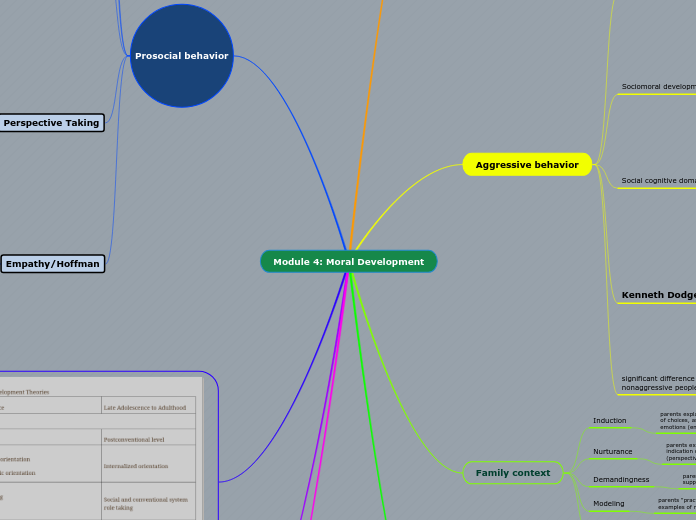por Jessika Vroman hace 3 años
365
Module 4: Moral Development
Aggressive behavior and moral development are deeply intertwined, with the key difference between aggressive and nonaggressive individuals being their interpretation of social cues.

por Jessika Vroman hace 3 años
365

Ver más
kids as young as 2/3 have awareness of others emotions & diff persp. can begin to understand what comforts them may not be what comforts others
toddlers begin to see diff between self & others. may attempt to comfort others but from own egocentric perspective
will seek comfort for own needs when they are exposed to another's cry or emotional distress
middle adolescents (12-15): individuals are capable of understanding social conventions that are relevant to everyone rather than only to 1 individual
early adolescents (10-12): able to take the perspective of 3rd party to understand how 2 individuals influence each other in a mutual, simultaneous manner.
older elem kids (8-10): can understand the relationship between self & others perspective, enabling them to speculate on how another will feel
early elem (6-8): understand that others have thoughts n feelings that may be diff than own but do NOT understand how diff perspectives are related
Preschool-age children (3-6) understand that other individuals have thoughts & feelings but confuse their own emotions w/ those of others or have difficulty understanding the causes of other's feelings
individuals behave in prosocial ways due to their personal values rather than external authority or expectations
to determine whether their actions will result in positive feelings or feelings of guilt, individuals use empathy & perspective taking, ability to understand another person's situation or psychological state, such as their thoughts or feelings
individuals engage in prosocial behavior based on the stereotypical beliefs about a person, helping a person considered to be "a good person" & not helping a "bad person"
individuals focus on the needs of others, even when hose needs conflict w/ one's self interest
individuals focus on the consequence to the self or self interest as a motive for prosocial behavior
visual displays can be provided in classroom to increase awareness of moral issues & to encourage charitable behavior, a positive attitude, and an awareness of environmental concerns
characters w/in an academic until can be discussed from a moral standpoint
history lessons & classic lit include moral dilemmas, as do current events in social studies classes
can increase prosocial behavior and decrease aggressive behavior among students
BC adolescents will begin to view more power & control teachers should give adolescents more opportunities to contribute to the development of rules & to make choices w/in the classroom (democratic governance)
teachers should hold regular class meetings & include collaboratively problem-solving to stop misbehavior in the classroom
rules should include prosocial behaviors such as sharing, taking turns, & respecting others
teachers SHOULD help students understand the reasons behind rules
teachers SHOULD be consistent & predictable in their responses & routine behaviors to impart a sense of trustworthiness
teachers can interact w/ students outside of instructional time such as having lunch w/ kids, engaging them in ordinary conversations about events, joking with students, allowing them to "goofy
teachers can share minor person info w/ students about family, pets, & hobbies as well as spend time learning about students hobbies, interests & family life
kids should feel safe to express emotions, knowing that they are supported & cared for by teachers & staff
tendency to interpret another person's intentions as hostile
6. behavioral enactment
individuals behave according to their decision to respond
5. response decision
people evaluate the past responses & select the most appropriate response based on the expected outcome
4. response decision
people attempt to remember past responses to similar situations
3. clarification of goals
people determine goals or outcomes for the situation
2. Interpretation of cues
people determine meaning for those cues & causes of the behavior of others in the social environment
1. encoding cues
people pay attention to some info in their social environment & dismiss other information
the least serious infractions
most serious infraction
individuals will escape responsibilities for their actions by viewing their behavior as less serious than social conventions might judge
see themselves as the victims rather than those they have victimized
other variables: exposure to violent TV or video games
cultural differences
peer influence such as friends that are aggressive
family influence such as family violence & abuse from parents or siblings
biological predispositions such as hormones or genetics
r
focuses on the rights of individuals
moves beyond simple consequences & away from external authorities to an internal authority
morality of individual principles
morality of social contract
personal convictions about what is right vs wrong
individual focuses on external authorities such as conventions & standards of society when determine right vs wrong
social authority
interpersonal authority
egocentrism: focus on one's self w/ little consideration for other people or their perspectives
defined by an egocentric, self-interested view of right or wrong and disregards conventions or standards of society
naive hedonistic
punishment/obedience
autonomy; they understand that in certain situations or under particular circumstances rules can be bent
they begin to see the complexity of right vs wrong; such as when lying may be necessary to spare someone's feelings or killing someone for self defense
kids believe that right vs wrong are determined by consequences of behavior as given by adult authority figures